Effects of an Inclined Blade on the Performance of a Sirocco Fan
Abstract
Featured Application
Abstract
1. Introduction
2. Numerical Methods
2.1. Baseline and Modified Models
2.2. Numerical Simulation Method
2.3. Node Independence Study
3. Results and Discussion
3.1. Validation against Experimental Results
3.2. Qualitative and Quantitative Results
3.2.1. Velocity Distribution in the Impeller Passage
3.2.2. Vorticity Distribution within the Fan
4. Conclusions
Author Contributions
Funding
Conflicts of Interest
References
- Bhope, D.V.; Padole, P.M. Experimental and theoretical analysis of stresses, noise and flow in centrifugal fan impeller. Mech Mach. Theory 2004, 39, 1257–1271. [Google Scholar] [CrossRef]
- Madhwesh, N.; Karanth, K.V.; Sharma, N.Y. Investigations into the flow behavior in a nonparallel shrouded diffuser of a centrifugal fan for augmented performance. J. Fluids Eng. 2018, 140, 081103. [Google Scholar] [CrossRef]
- Madhwesh, N.; Karanth, K.V.; Sharma, N.Y. Effect of innovative circular shroud fences on a centrifugal fan for augmented performance—A numerical analysis. J. Mech. Sci. Technol. 2018, 32, 185–197. [Google Scholar] [CrossRef]
- Tamaki, H. Experimental study on the effect of diffuser vane setting angle on centrifugal compressor performance. J. Turbomach. 2017, 139, 061001. [Google Scholar] [CrossRef]
- Wang, Y.; Dong, Q.L.; Zhang, Y.L. Meridional shape design and the internal flow investigation of centrifugal impeller. Proc. Inst. Mech. Eng. Part C J. Mech. Eng. Sci. 2017, 231, 4319–4330. [Google Scholar] [CrossRef]
- Jiang, B.Y.; Liu, H.; Li, B.; Wang, J. Effects of cut volute profile on squirrel cage fan performance and flow field. Adv. Mech. Eng. 2018, 10, 1–14. [Google Scholar] [CrossRef]
- Lv, Y.K.; Lv, Z.W.; Li, H.Y.; Song, B.J.; Cheng, B.; Zhang, B. Design of volute shape of centrifugal fans. Proc. Inst. Mech. Eng. Part A J. Power Energy 2016, 230, 141–153. [Google Scholar] [CrossRef]
- Li, C.X.; Wang, S.L.; Jia, Y.K. The performance of a centrifugal fan with enlarged impeller. Energy Convers. Manag. 2011, 52, 2902–2910. [Google Scholar] [CrossRef]
- Patil, S.R.; Chavan, S.T.; Jadhav, N.S.; Vadgeri, S.S. Effect of volute tongue clearance variation on performance of centrifugal blower by numerical and experimental analysis. Mater. Today Proc. 2018, 5, 3883–3894. [Google Scholar] [CrossRef]
- Prezelj, J.; Novakovic, T. Centrifugal fan with inclined blades for vacuum cleaner motor. Appl. Acoust. 2018, 140, 13–23. [Google Scholar] [CrossRef]
- Kim, J.H.; Cha, K.H.; Kim, K.Y. Parametric study on a forward-curved blades centrifugal fan with an impeller separated by an annular plate. J. Mech. Sci. Technol. 2013, 27, 1589–1595. [Google Scholar] [CrossRef]
- Wu, Y.; Dou, H.S.; Wei, Y.K.; Chen, X.P.; Chen, Y.N.; Cao, W.B. Effect of attack angle on flow characteristic of centrifugal fan. Mater. Sci. Eng. 2016, 129, 012059. [Google Scholar] [CrossRef]
- Zhang, L.; Wang, S.L.; Hu, C.X.; Zhang, Q. Multi-objective optimization design and experimental investigation of centrifugal fan performance. Chin. J. Mech. Eng. 2013, 26, 1267–1276. [Google Scholar] [CrossRef]
- Jung, U.H.; Kim, J.H.; Kim, J.H.; Park, C.H.; Jun, S.O.; Choi, Y.S. Optimum design of diffuser in a small high-speed centrifugal fan using CFD & DOE. J. Mech. Sci. Technol. 2016, 30, 1171–1184. [Google Scholar] [CrossRef]
- Chen, G.L.; Xu, W.; Zhao, J.Y.; Zhang, H.P. Energy-saving performance of flap-adjustment-based centrifugal fan. Energies 2018, 11, 162. [Google Scholar] [CrossRef]
- Younsi, M.; Bakir, F.; Kouidri, S.; Rey, R. Numerical and experimental study of unsteady flow in a centrifugal fan. Proc. Inst. Mech. Eng. Part A J. Power Energy 2007, 221, 1025–1036. [Google Scholar] [CrossRef]
- Jeon, W.H. A numerical study on the effects of design parameters on the performance and noise of a centrifugal fan. J. Sound Vib. 2003, 265, 221–230. [Google Scholar] [CrossRef]
- Wang, S.L.; Zhang, L.; Zhang, Q.; Ye, X.M. Numerical investigation of entropy generation and optimization on a centrifugal fan. Adv. Sci. Lett. 2011, 4, 2240–2245. [Google Scholar] [CrossRef]
- Yu, Z.; Li, S.; He, W.Q.; Wang, W.X. Numerical simulation of flow field for a whole centrifugal fan and analysis of the effects of blade inlet angle and impeller gap. HVAC R Res. 2005, 11, 263–283. [Google Scholar] [CrossRef]
- Rong, R.; Cui, K.; Wu, Z.R. Numerical study of centrifugal fan with slots in blade surface. Procedia Eng. 2015, 126, 588–591. [Google Scholar] [CrossRef][Green Version]
- Zhang, J.; Chu, W.; Zhang, J.; Lv, Y. Vibroacoustic optimization study for the volute casing of a centrifugal fan. Appl. Sci. 2019, 9, 859. [Google Scholar] [CrossRef]
- Zhang, W.; Chen, X.; Yang, H.; Liang, H.; Wei, Y. Forced convection for flow across two tandem cylinders with rounded corners in a channel. Int. J. Heat Mass Trans. 2019, 130, 1053. [Google Scholar] [CrossRef]
- Wei, Y.; Yang, H.; Dou, H.-S.; Lin, Z.; Wang, Z.; Qian, Y. A novel two-dimensional coupled lattice Boltzmann model for thermal incompressible flows. Appl. Math. Comput. 2018, 339, 556. [Google Scholar] [CrossRef]
- Lun, Y.; Lin, L.; He, H.; Ye, X.; Zhu, Z.; Wei, Y. Effects of vortex structure on performance characteristics of a multiblade fan with inclined tongue. J. Power Energy 2019. [Google Scholar] [CrossRef]
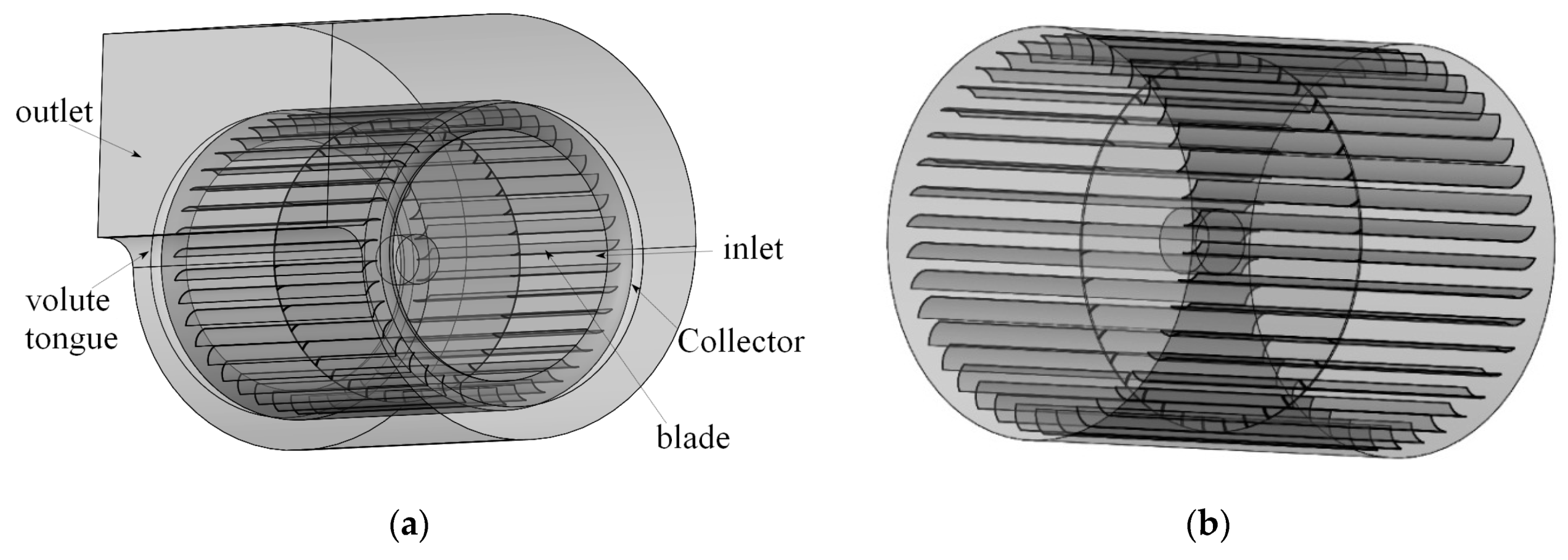
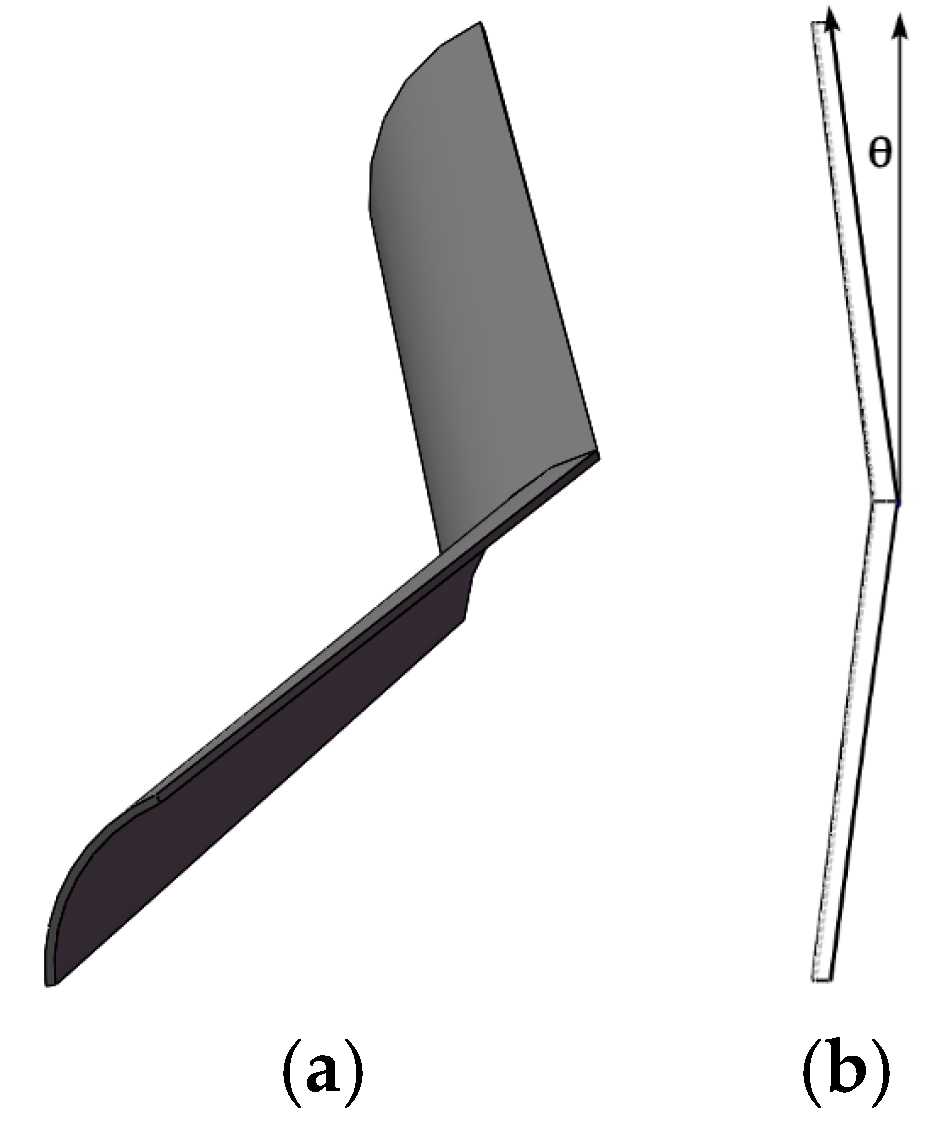
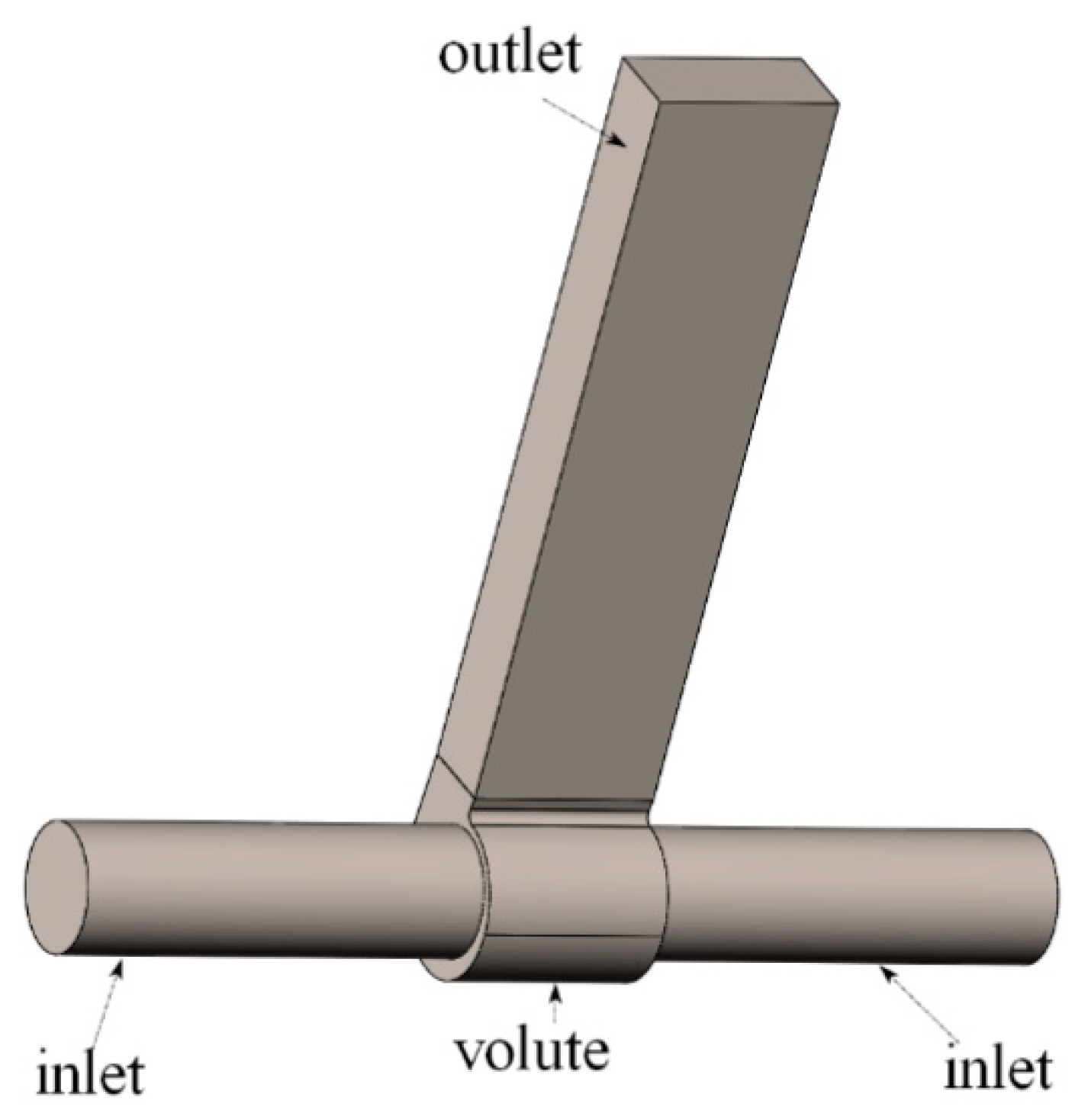
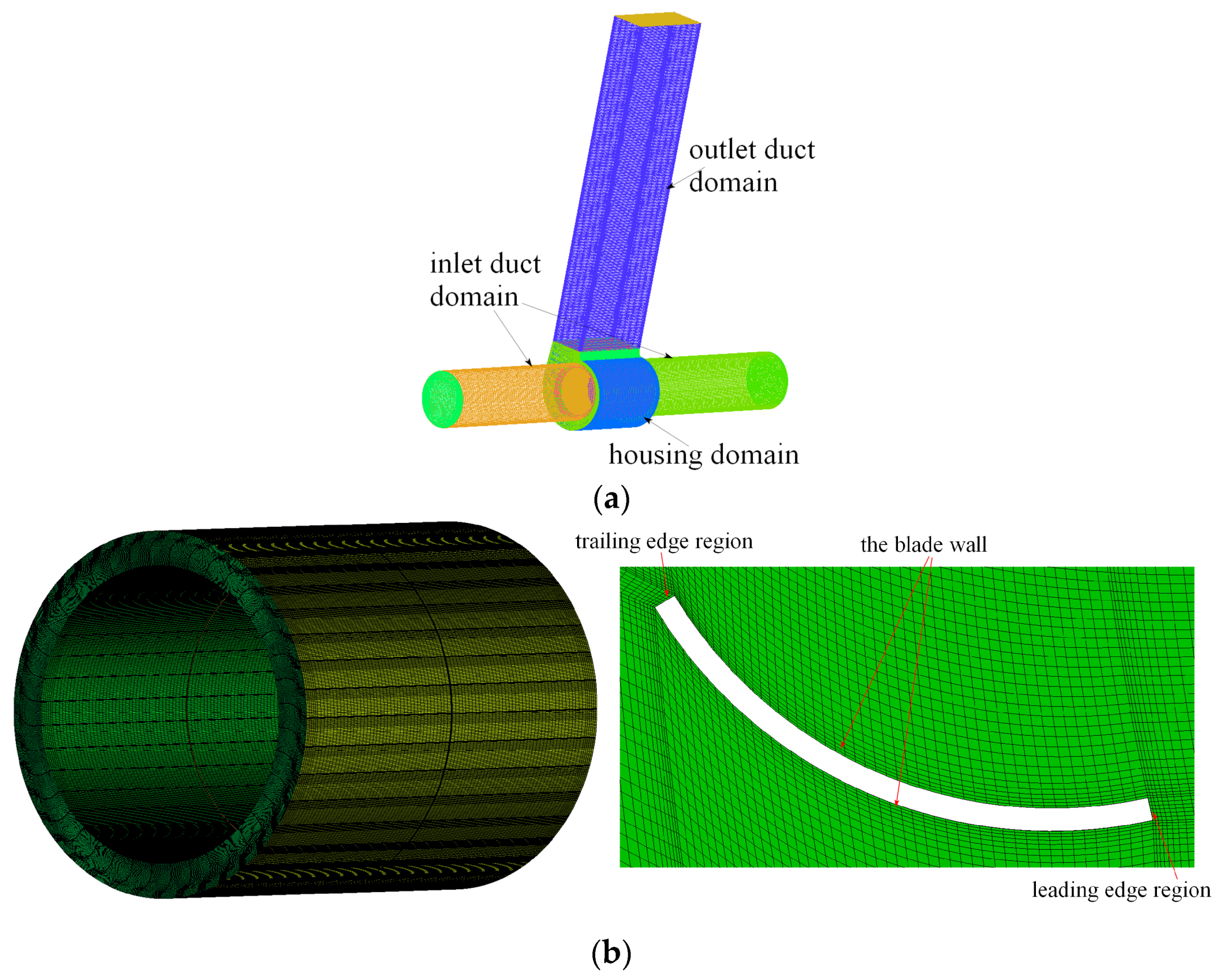
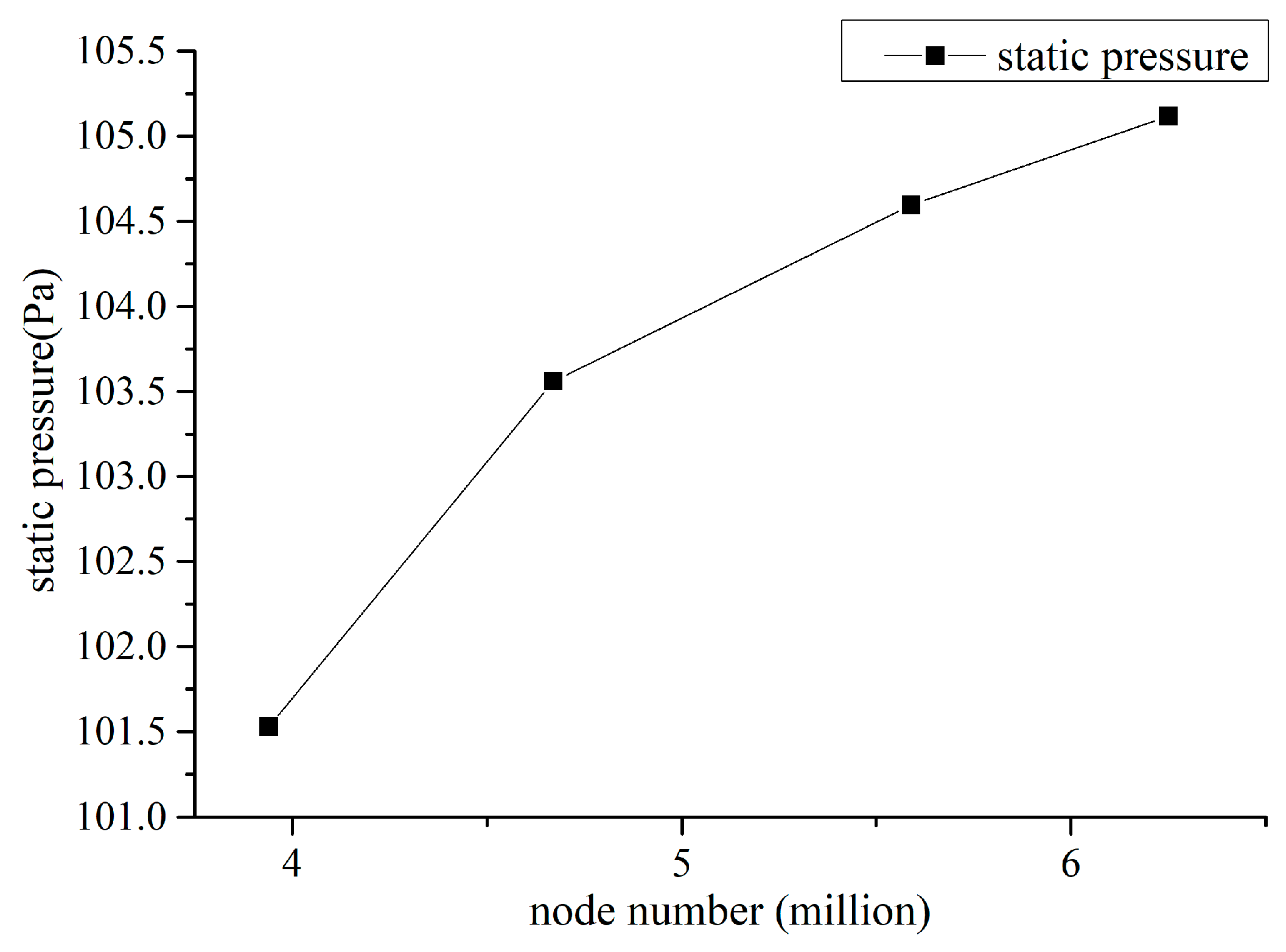
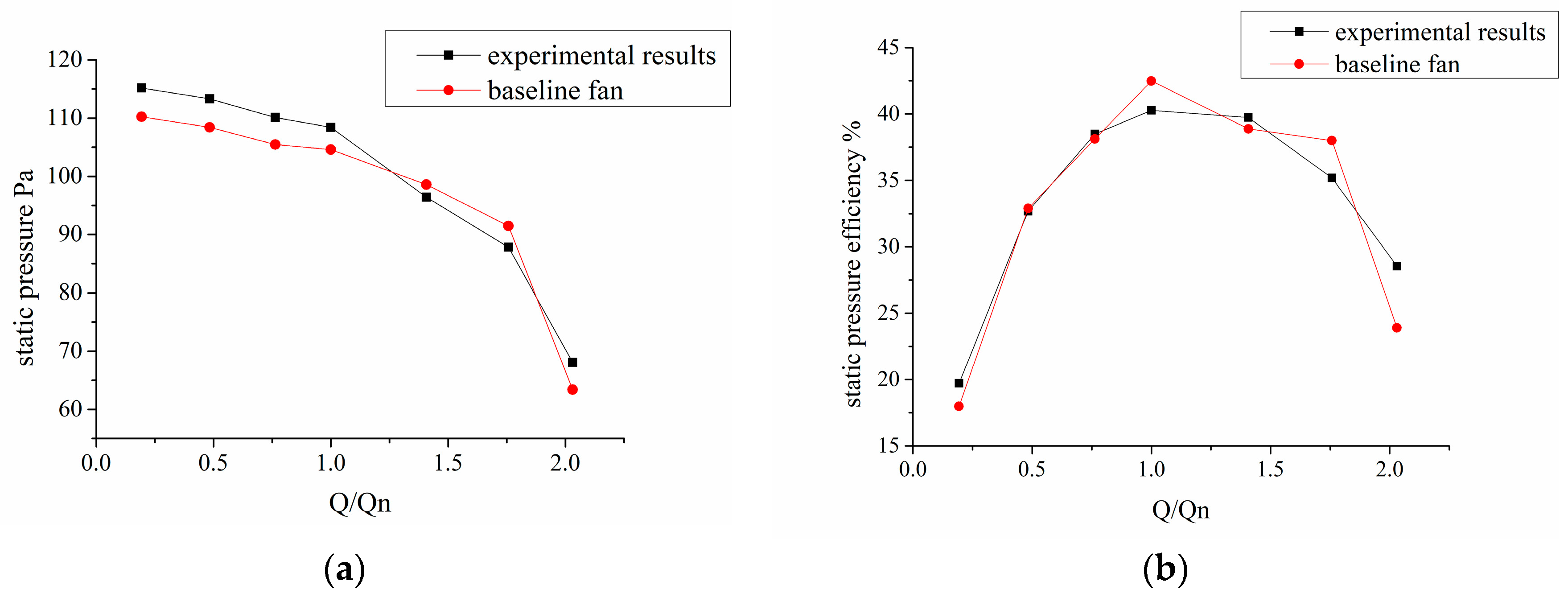
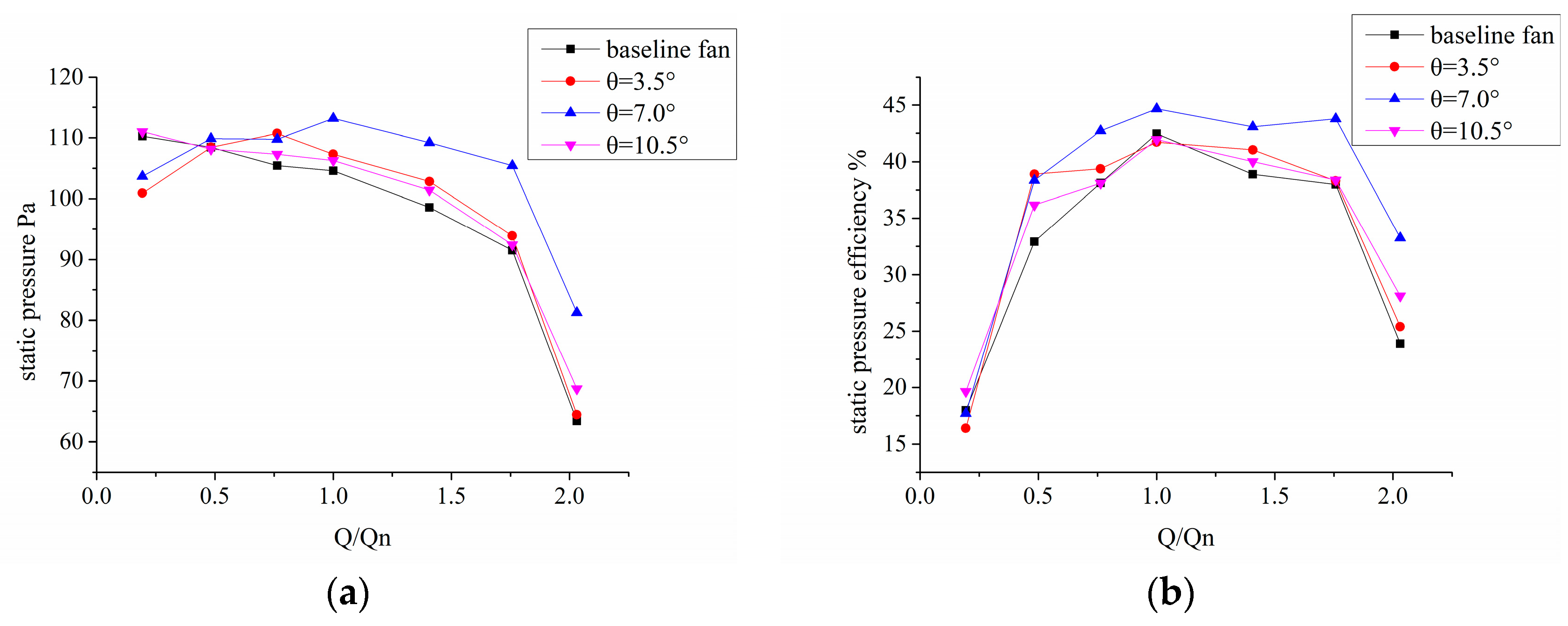


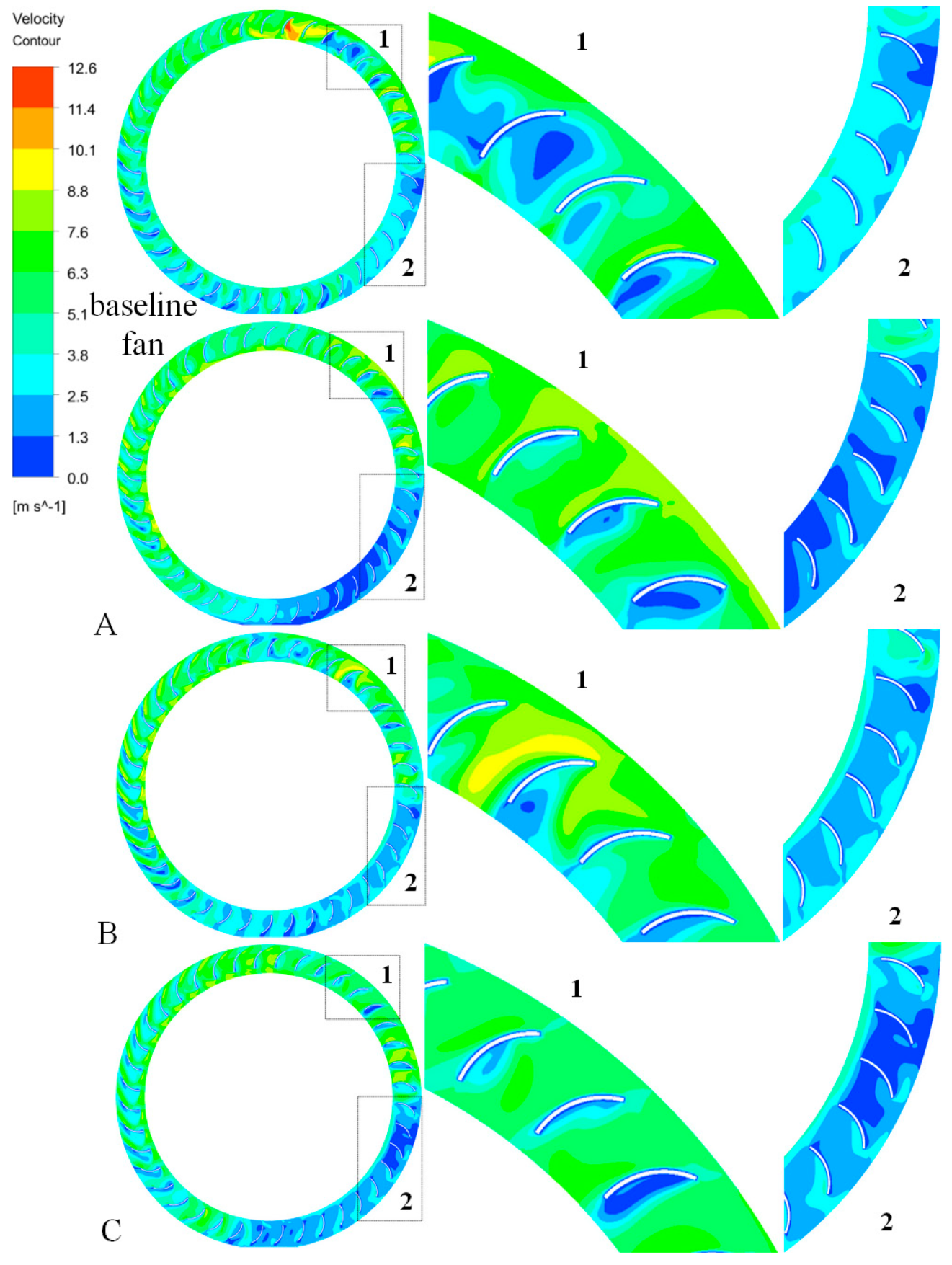
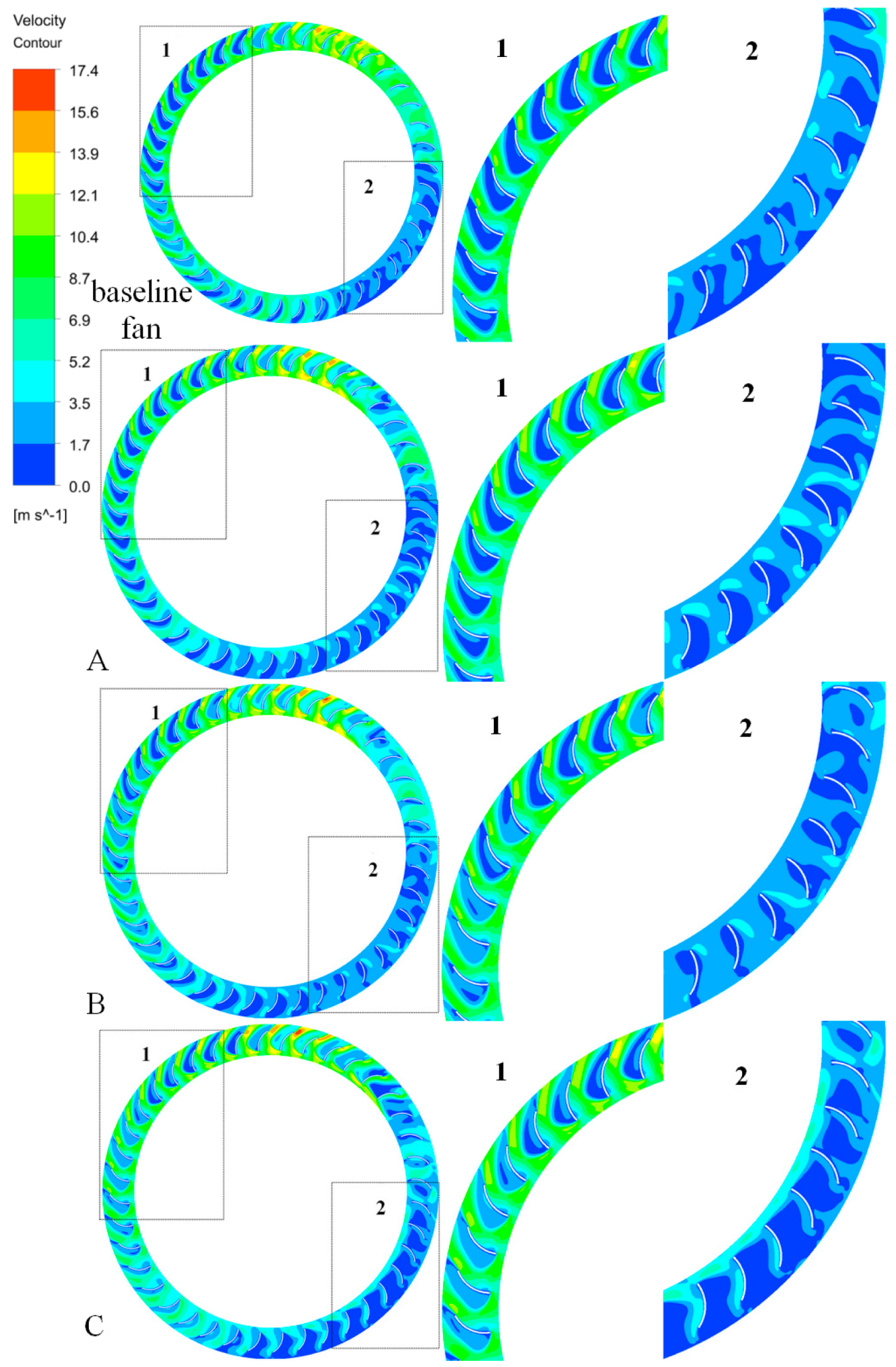
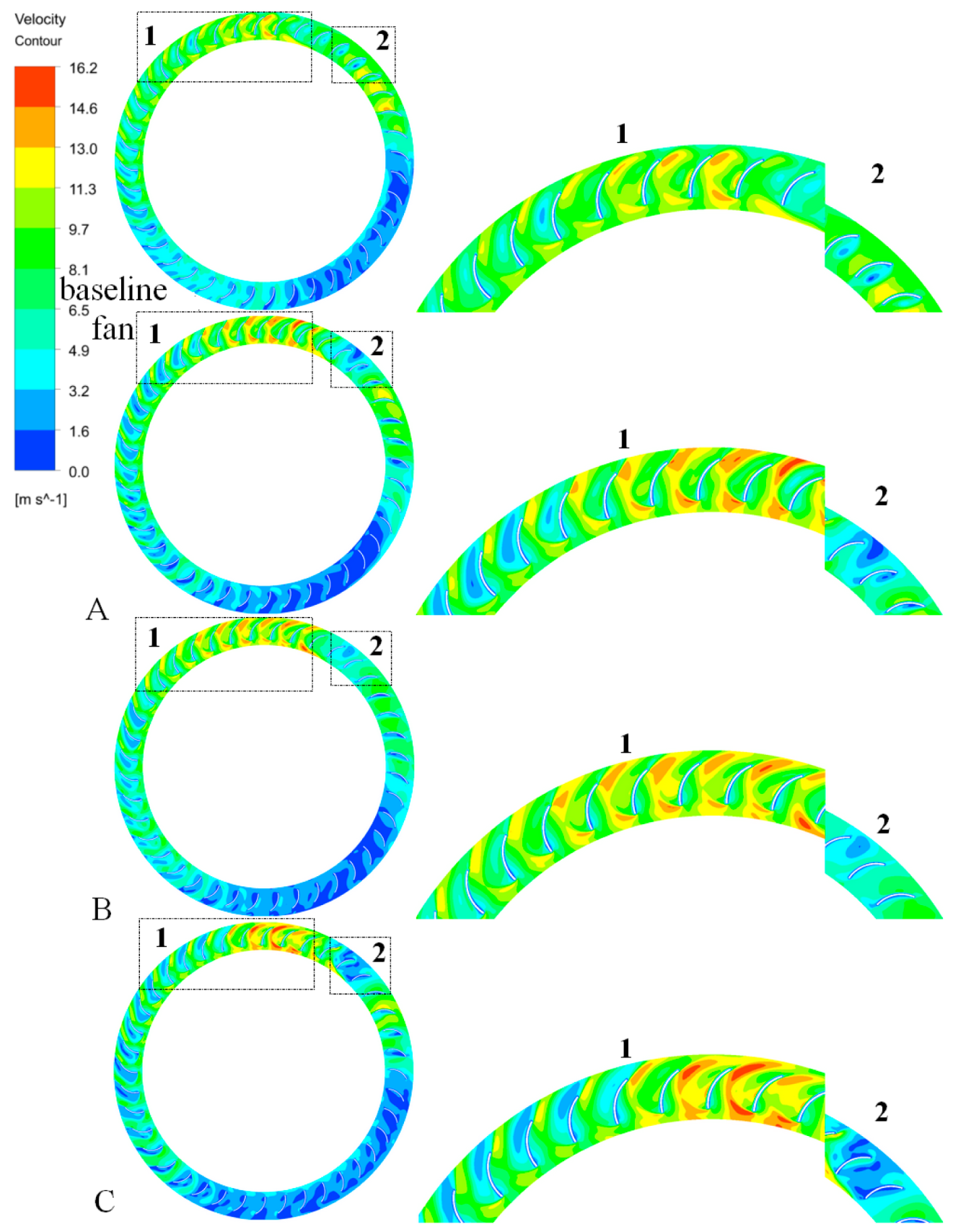

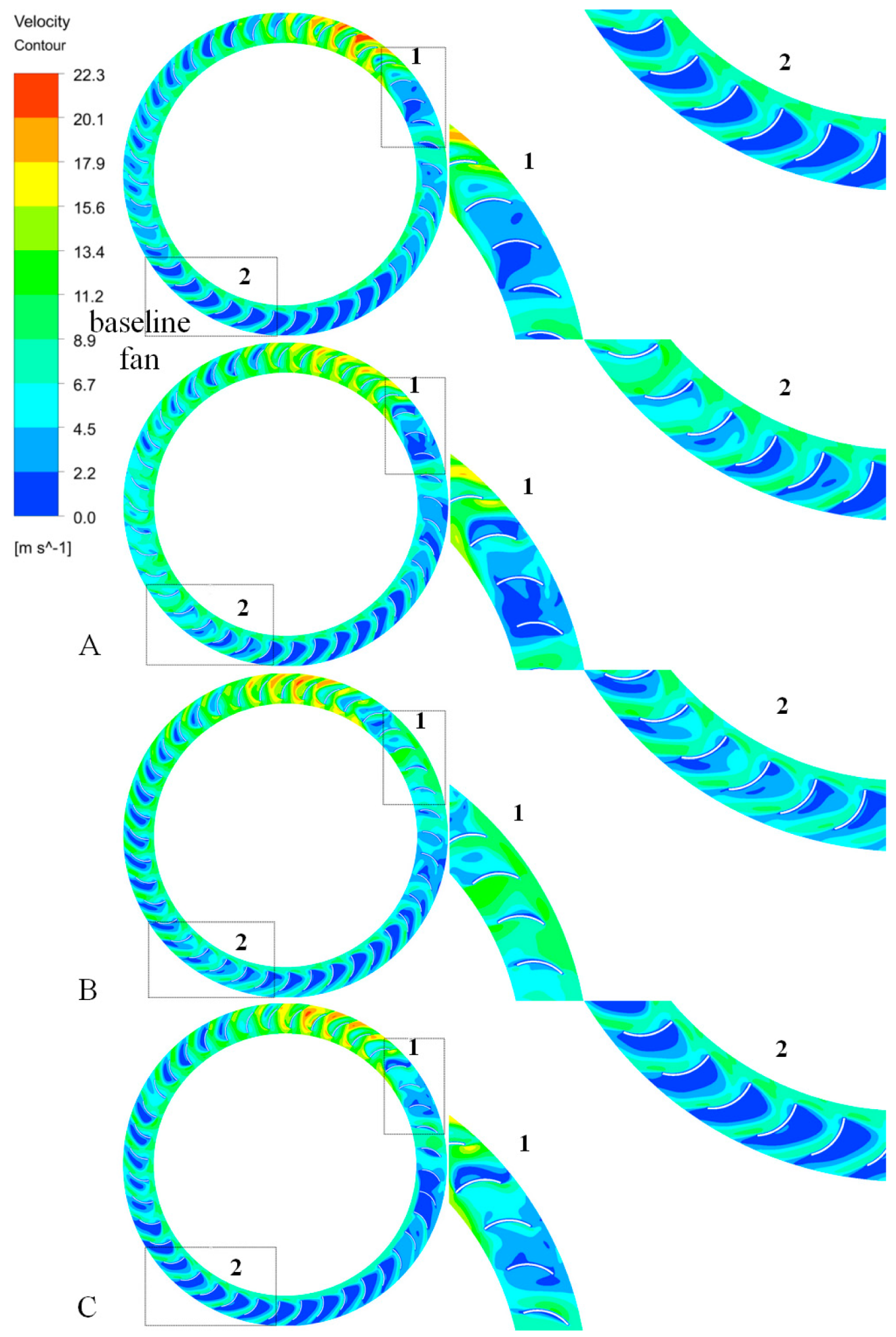
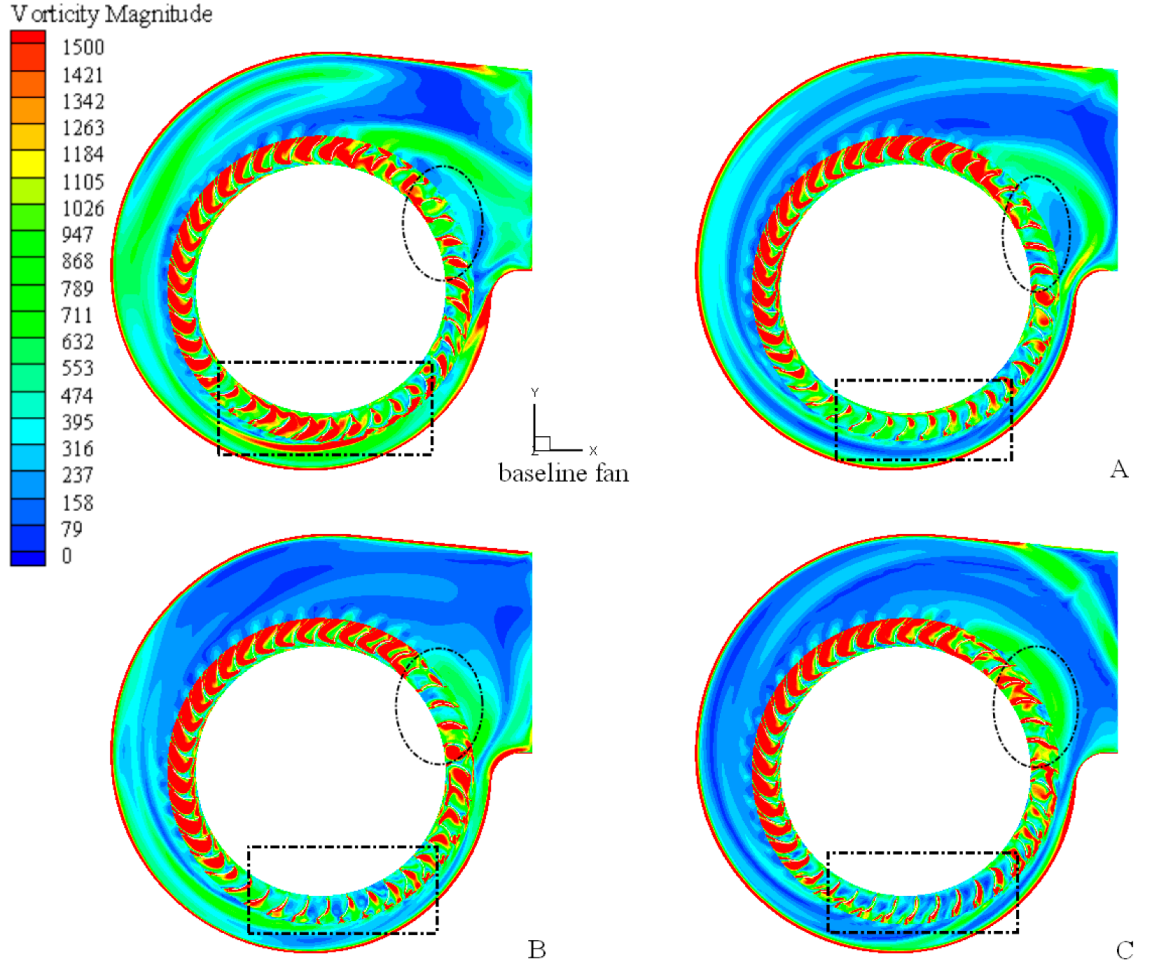
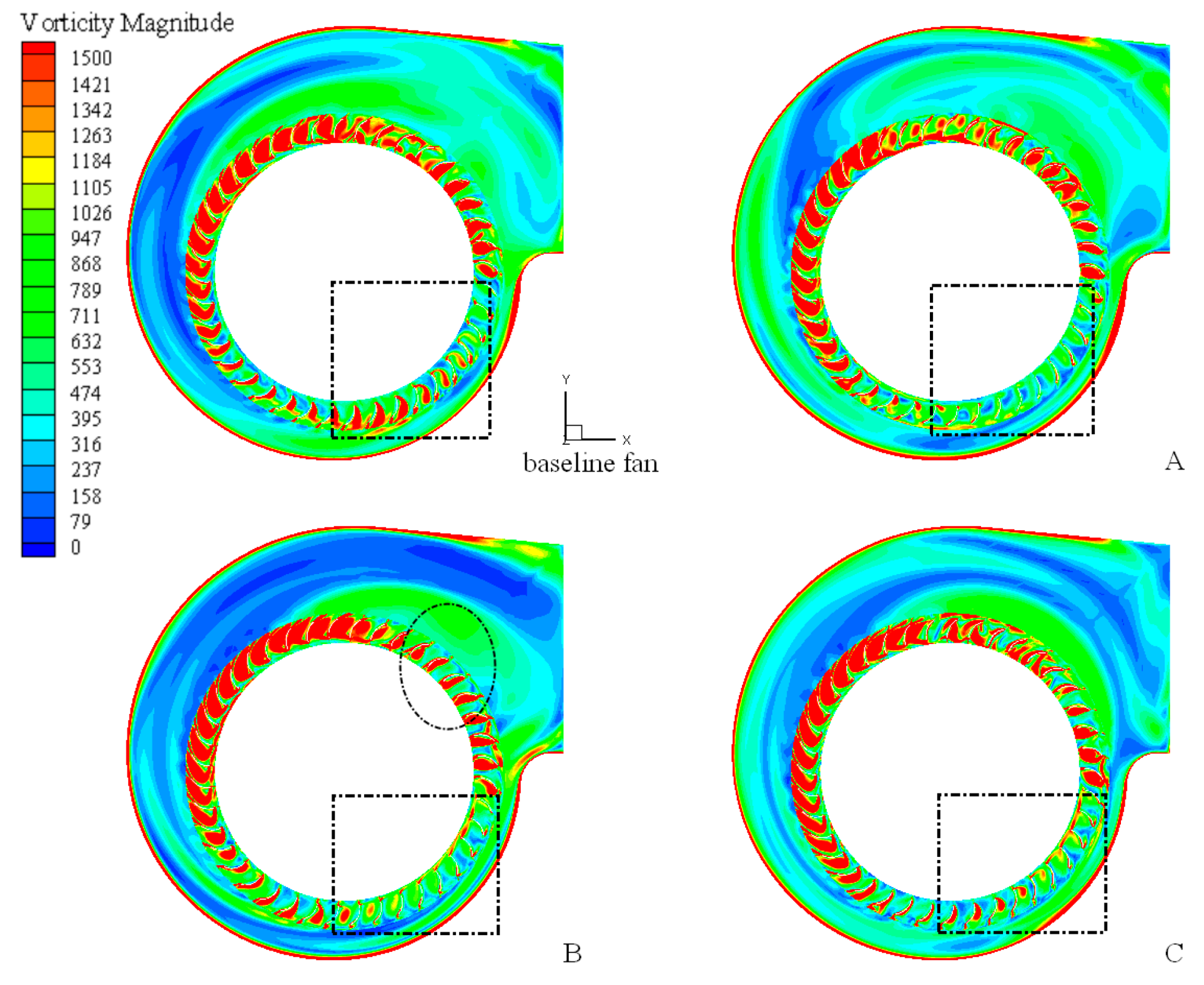

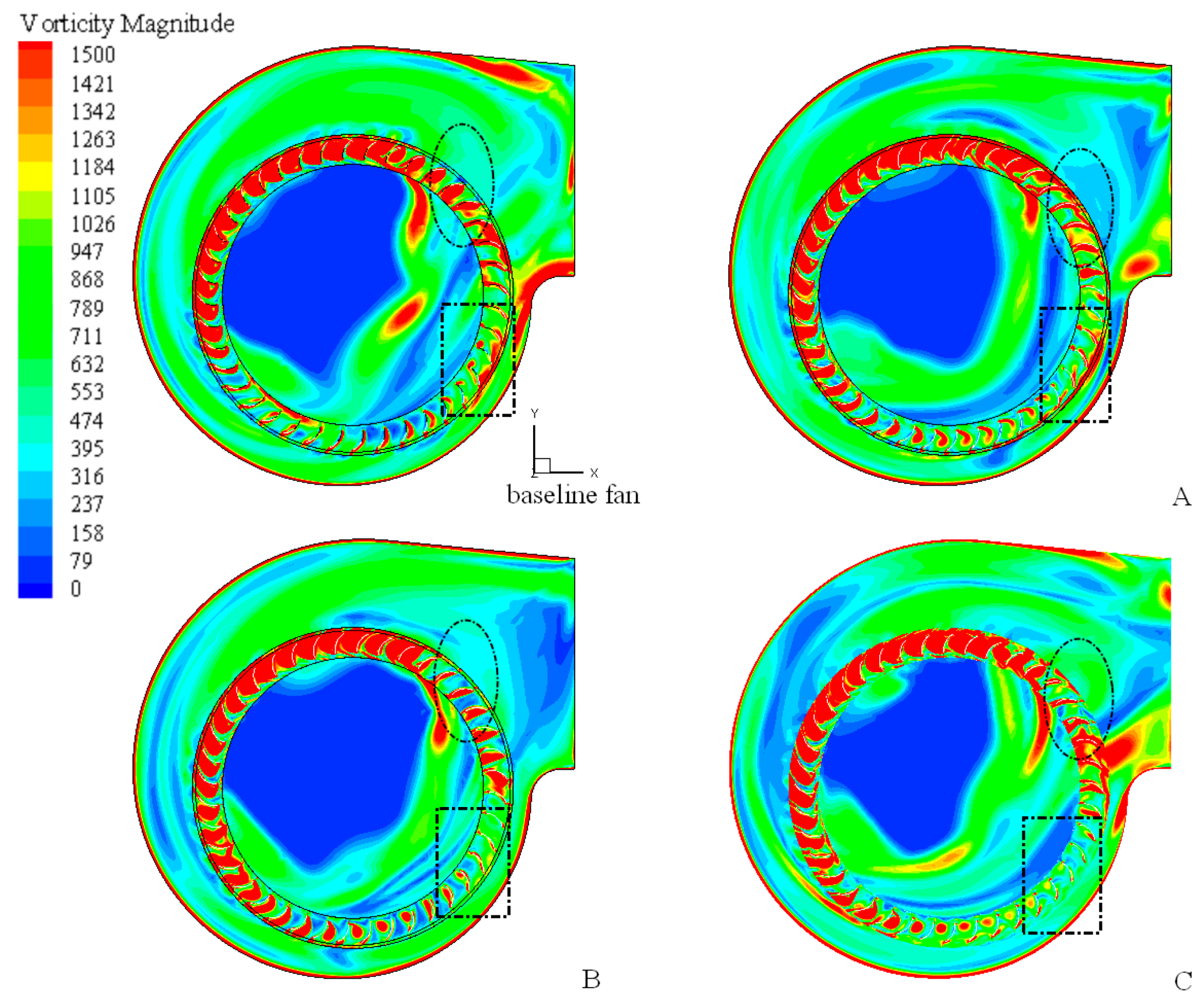
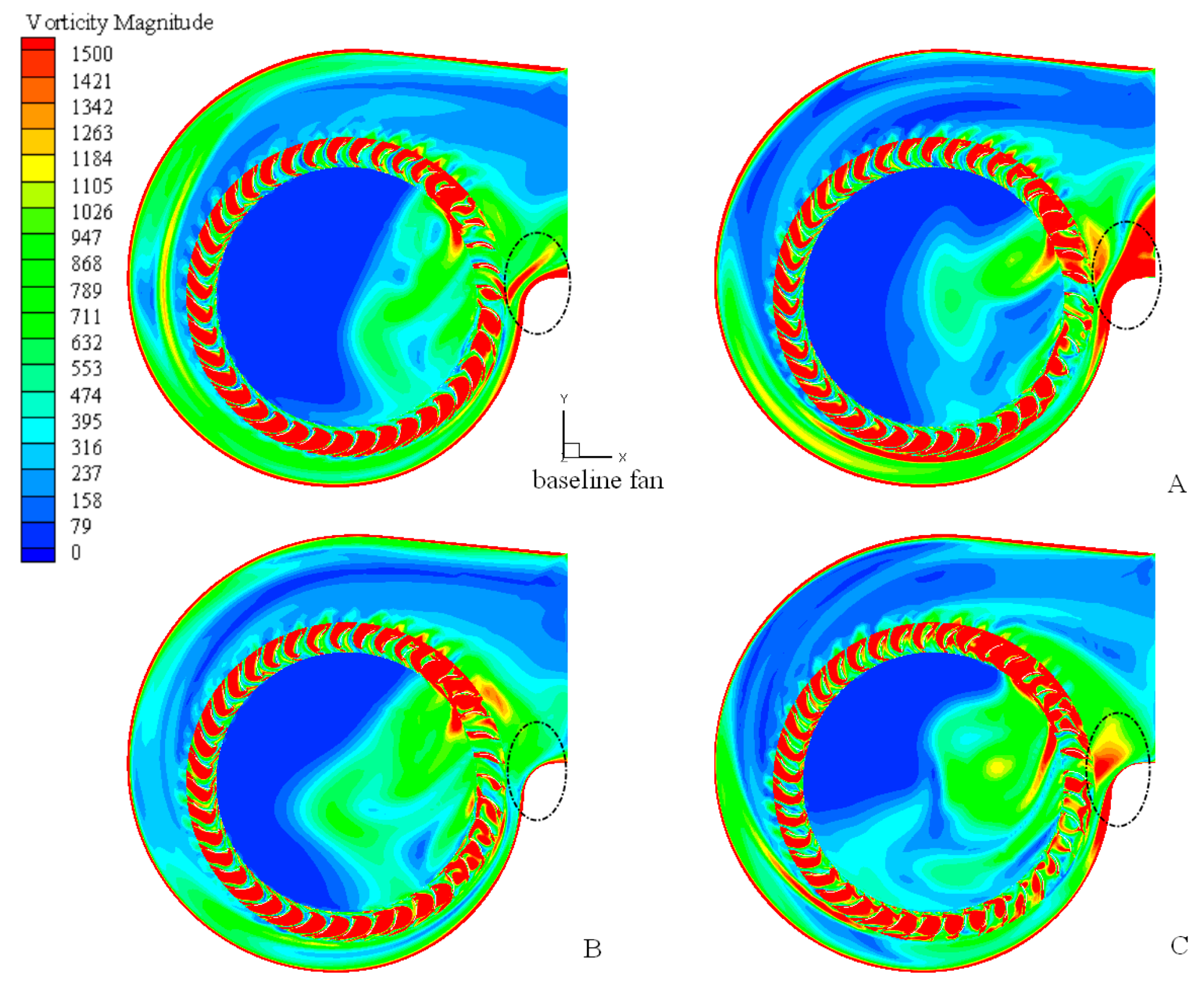

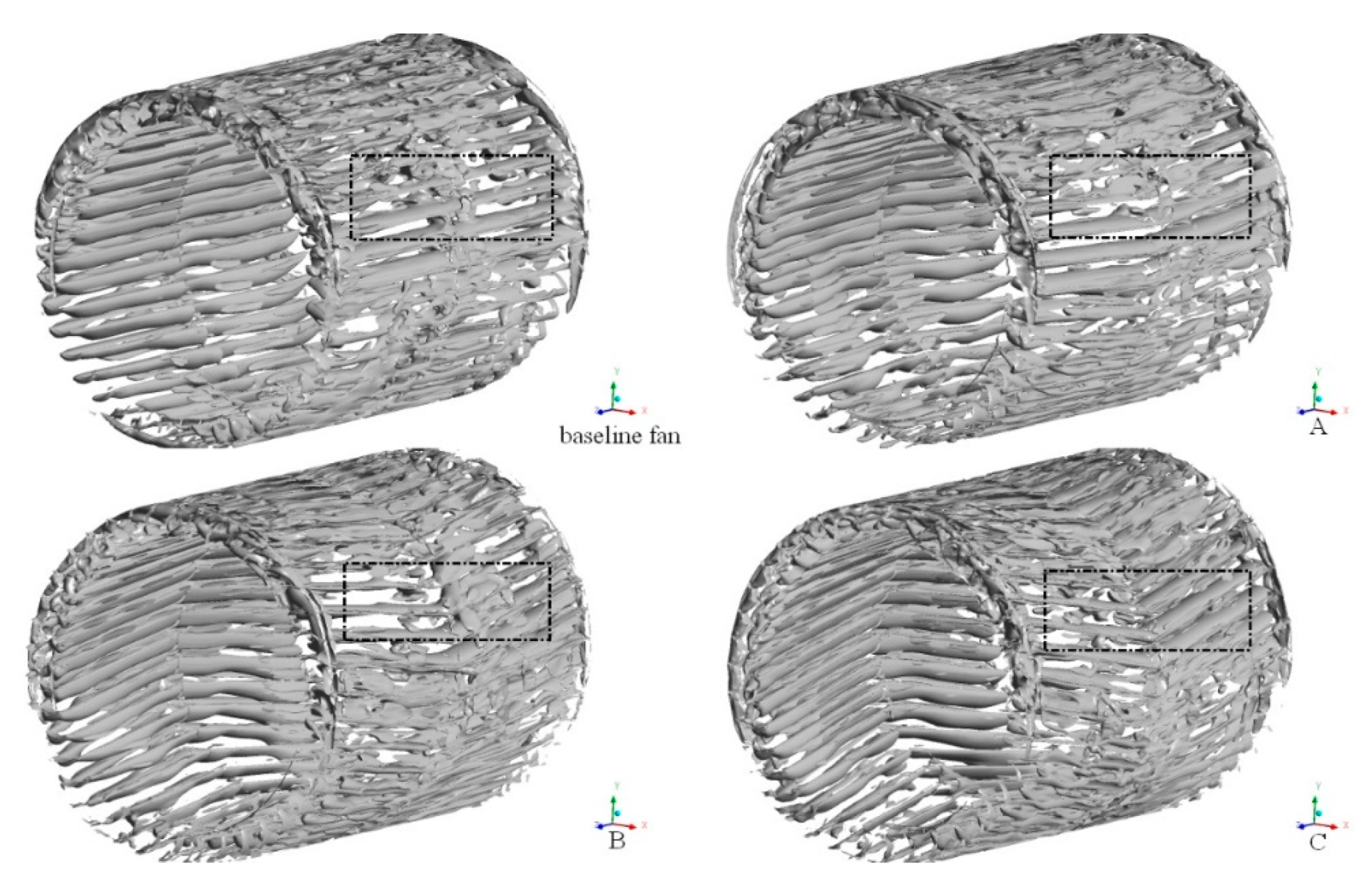
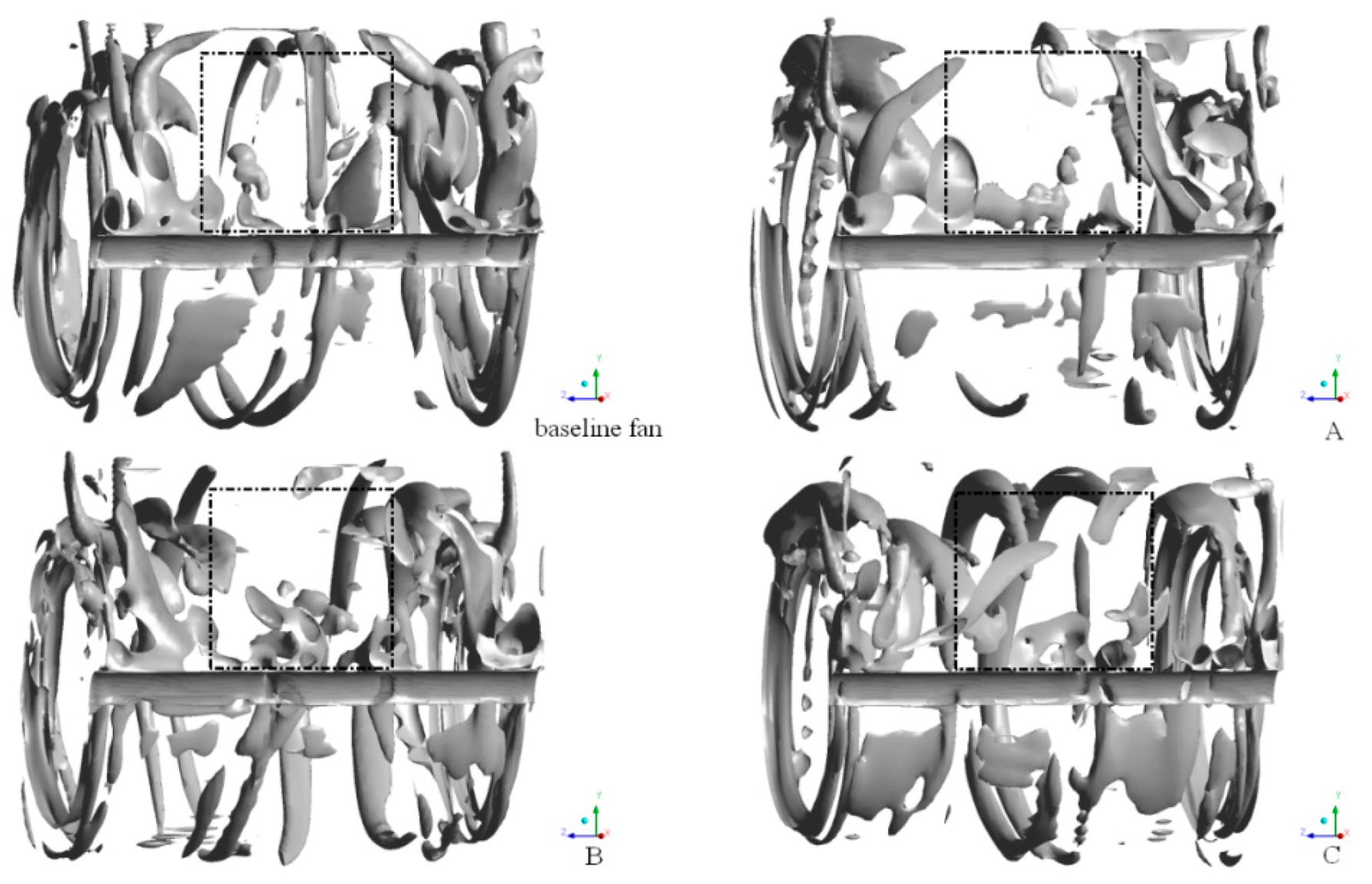
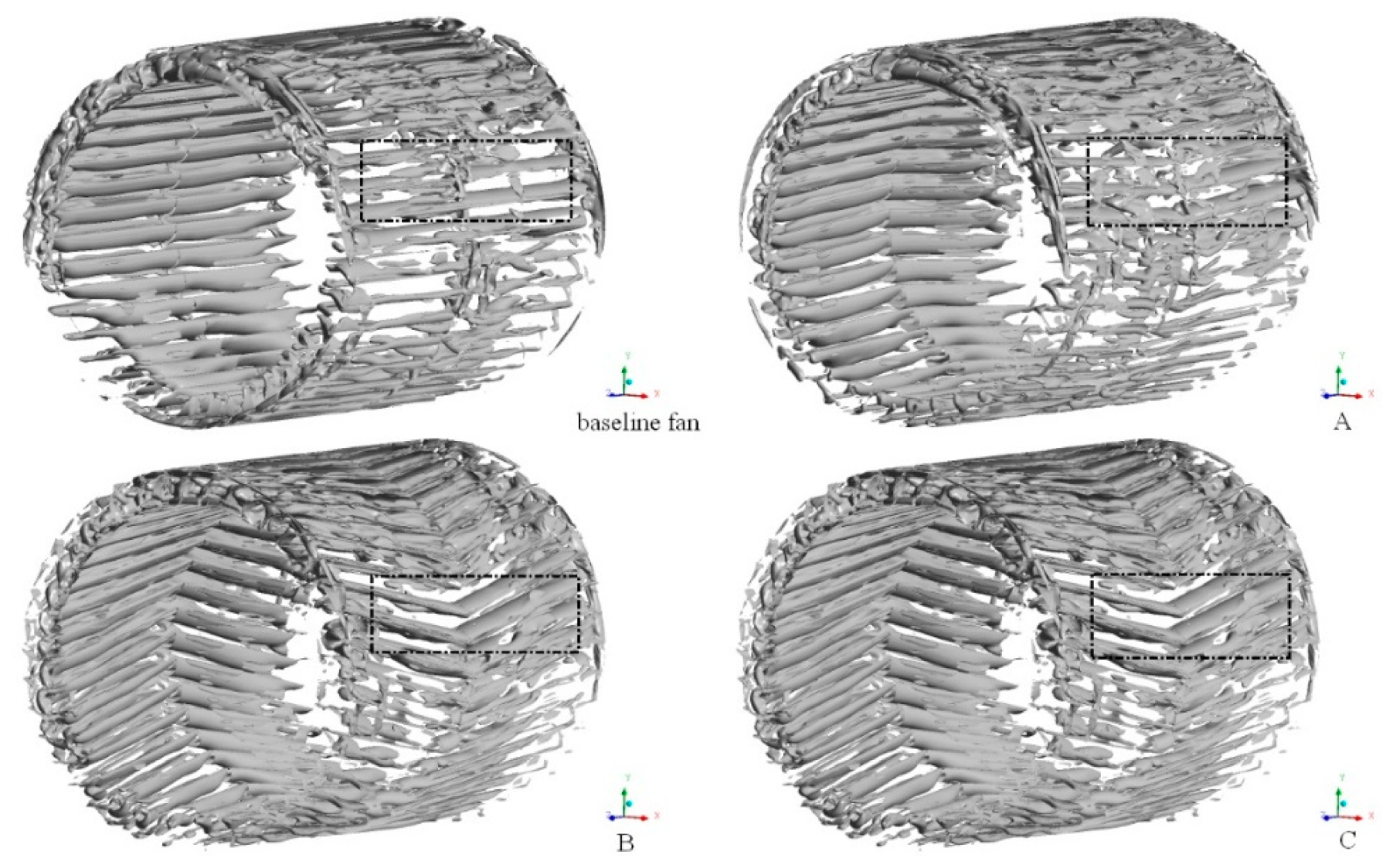
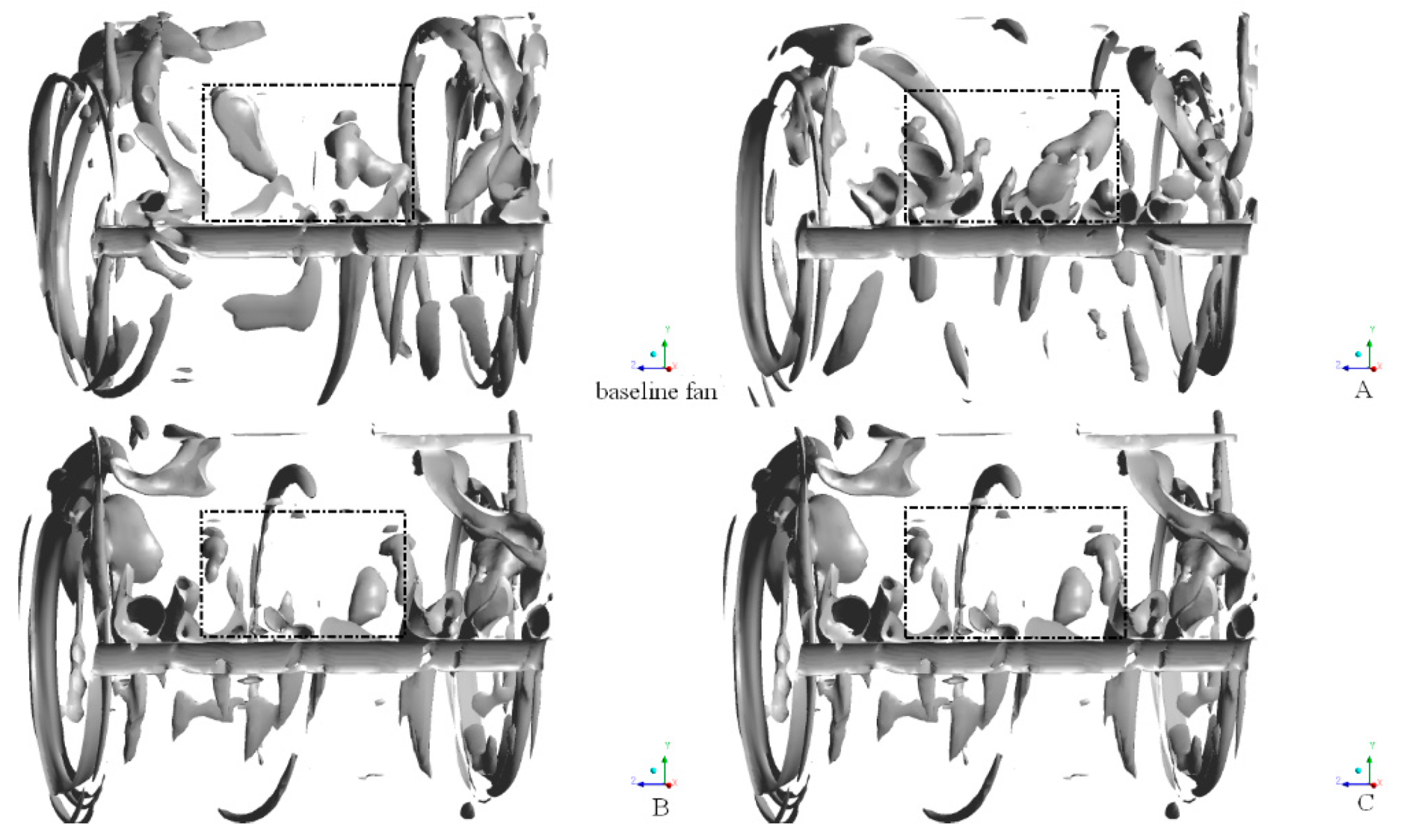

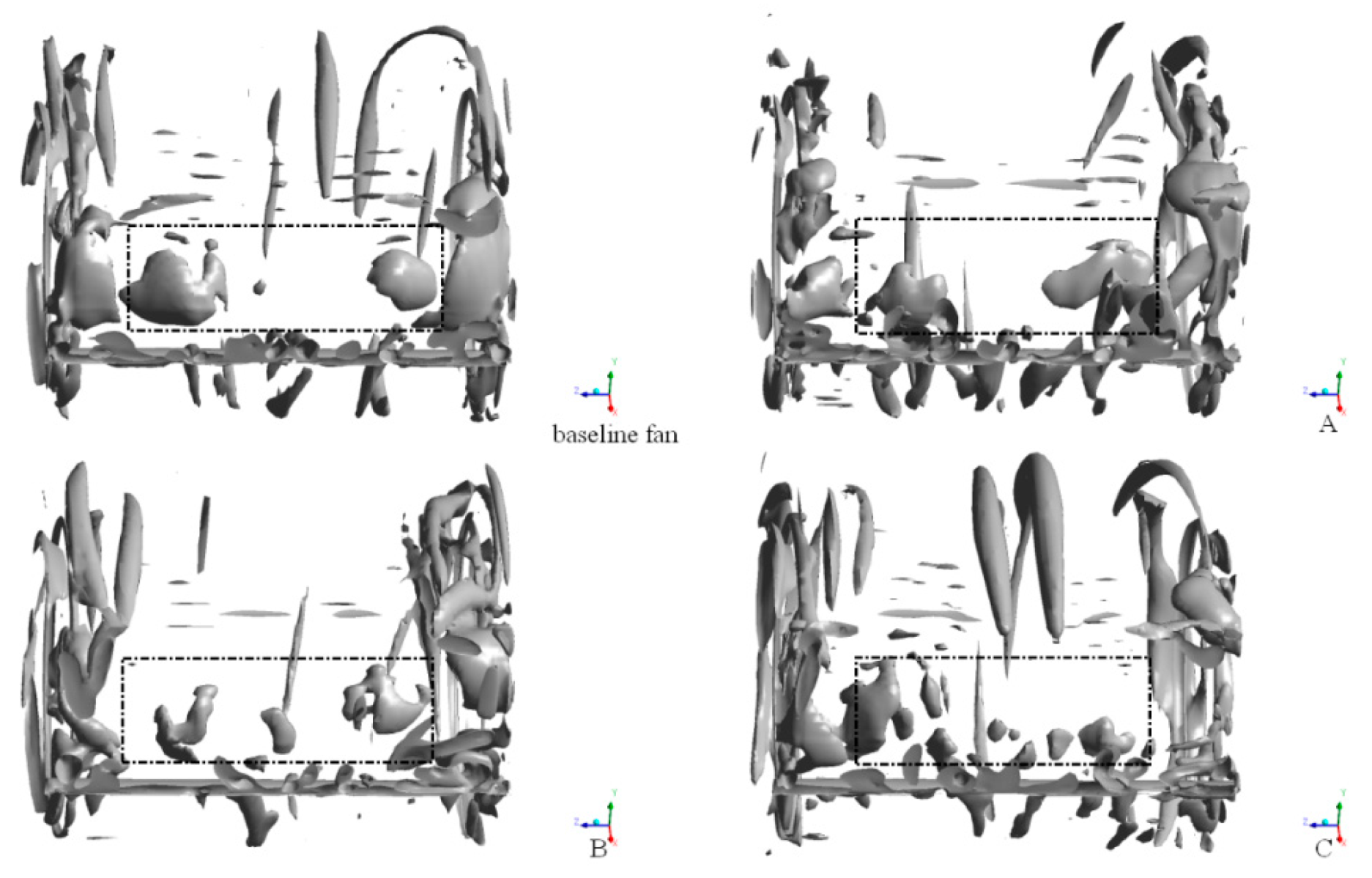
| Specification | Value |
|---|---|
| Flow volume (m3·s−1) | 0.0893 |
| Impeller length(mm) | 200 |
| Exit area of volute (mm2) | 23,139 |
| Rotation speed of impeller (rpm) | 1300 |
| Outlet diameter of impeller (mm) | 150 |
| Inlet diameter of impeller (mm) | 131.6 |
| Number of blades | 40 |
| Component | Number of Nodes/103 |
|---|---|
| Rotating wheel domain | 5640 |
| Inlet duct domain | 1120 |
| Outlet duct domain | 300 |
| Volute domain | 420 |
| All | 7480 |
© 2019 by the authors. Licensee MDPI, Basel, Switzerland. This article is an open access article distributed under the terms and conditions of the Creative Commons Attribution (CC BY) license (http://creativecommons.org/licenses/by/4.0/).
Share and Cite
Ni, S.; Cao, W.; Xu, J.; Wang, Y.; Zhang, W. Effects of an Inclined Blade on the Performance of a Sirocco Fan. Appl. Sci. 2019, 9, 3154. https://doi.org/10.3390/app9153154
Ni S, Cao W, Xu J, Wang Y, Zhang W. Effects of an Inclined Blade on the Performance of a Sirocco Fan. Applied Sciences. 2019; 9(15):3154. https://doi.org/10.3390/app9153154
Chicago/Turabian StyleNi, Shaosong, Wenbin Cao, Jun Xu, Yingdong Wang, and Wei Zhang. 2019. "Effects of an Inclined Blade on the Performance of a Sirocco Fan" Applied Sciences 9, no. 15: 3154. https://doi.org/10.3390/app9153154
APA StyleNi, S., Cao, W., Xu, J., Wang, Y., & Zhang, W. (2019). Effects of an Inclined Blade on the Performance of a Sirocco Fan. Applied Sciences, 9(15), 3154. https://doi.org/10.3390/app9153154





